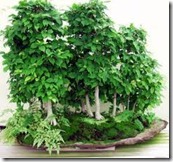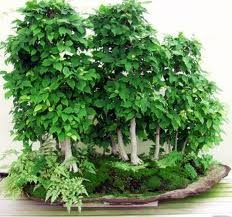 An alternative to purchasing a ‘starter bonsai’ from a nursery is for the enthusiast to cultivate a bonsai on one’s own. This can be achieved in a variety of ways; covered here are seedlings, cuttings, layering and grafting. As with all things bonsai, the species being propagated will have a major effect on the method of propagation and the techniques used.
An alternative to purchasing a ‘starter bonsai’ from a nursery is for the enthusiast to cultivate a bonsai on one’s own. This can be achieved in a variety of ways; covered here are seedlings, cuttings, layering and grafting. As with all things bonsai, the species being propagated will have a major effect on the method of propagation and the techniques used.
Bonsai from Seedlings
Seeds for bonsai plants can be obtained from nurseries, garden stores and mail order. Many types of trees are suitable for growing from seeds for the novice; they include Pines, Beech, and Maple. Buyers should beware of specialty stores that sell seed said to be specifically for bonsai. It should be remembered that bonsai plants are no different from regular plants, and give no further value for the price above regular seed.
Propagating from seeds should only be undertaken by the enthusiast that has much patience and time. It can take sometimes several seasons for certain kinds of seeds to germinate. A tree grown from a seed may take as long as five years before the tree is even ready to be considered for a bonsai.
To encourage a seed to germinate, it must experience conditions that match what is ideal for the species. For this reason, species that are native to the local area are ideal. Generally speaking, seeds are sown in autumn and lay dormant through the winter, germinating in the spring. It is best to sow a seed in a planting pot so that conditions can be more easily controlled. The germination should take about a month. Avoid fertilizing the seedling until one or two months after it starts growing up from the soil, the root system will be immature and easily damaged by the nitrogen in the fertilizer. The seedlings will grow into saplings, which can then be transferred to a growing pot to prepare them for bonsai training.
Bonsai from Cuttings
The process of propagating from cuttings involve snipping a portion of an existing plant and transferring it to a growing medium in which the cutting will develop its own roots. Growing a plant from a cutting can take much less time than growing one from a seed. Also, as bonsai plants are often pruned to maintain shape; the cuttings taken from the pruning process can be used to to propagate new plants.
Cuttings for bonsai propagation are always taken from the stem, not the root or leaf. When cuttings are made from an existing plant, they should be done at a diagonal. This provides more surface area for roots to spawn. There are three types of cuttings: hardwood, softwood and semi-ripe. The type of cutting method used will be determined by the species.
Hardwood cuttings are taken from the plant after it has lost its leaves, in the autumn, before becoming completely dormant. Once placed in the rooting medium, hardwood cuttings are placed outside. They should be cared for during the winter the same as the plant they came from. Hardwood cuttings should not be replanted until a root system has been established, often more than a year from when they were originally cut.
Semi-ripe (and also ripe) cuttings are still green when taken. This is done towards the end of summer. Semi-ripe and ripe cuttings need to be kept in a humid environment, and this is often done with the aid of a propagator. If the propagator is kept outside during the warmer months, it should be kept out of direct sun.
Softwood cuttings are taken earlier in the summer or in the spring, and it is best if they are taken in the morning. As with semi-ripe cuttings, they should then be placed in a propagator and kept warm, but out of direct sunlight. Softwood cuttings will show signs of growth the soonest out of all the methods of cutting; but patience must be practiced as they will still not have the strength of root to be planted until the following spring.
The ends of all cutting should be covered with a root hormone before planting. Many commercially available root hormones also contain fungicide to protect the cuttings from infestations.
Bonsai from Layering
Layering is a method of propagating a new plant from the old without initially cutting. There are two methods of layering; ground and air layering.
Ground layering is a method that in some species occurs naturally. In nature, a low-growing branch may reach the ground and begin producing roots. To encourage this, in the spring a relatively new growth close to the ground is cut on the underside of the branch and covered with root hormone. The branch is bent towards the ground, the cut in the branch covered with sphagnum moss and buried. The area in which the branch is buried must be kept damp. Often the buried part of the tree will develop new roots in 3 months, although the process may take longer. Once one is sure the new roots are well established, the new plant can be removed from the parent.
Air layering is the same principle as ground layering, but happens higher up the plant and a plastic bag is used to contain the growth medium. The most common way to do this is to remove a ring of bark a couple of inches wide from below an existing branch. The first layer after the bark must also be removed, or the tree will simply reform bark over the wound. Again, root hormone is applied to the wound and sphagnum moss is wrapped around it and held in place with clear plastic. In three or four months new roots should appear in the bag. At this junction the moss will need to be kept damp. The roots should be given a few more weeks to strengthen, and then separated from the parent plant and planted. The new plant should be pruned judiciously as it will need all its strength in developing the new root system.
Bonsai from Grafting
Grafting is a difficult method of propagation not to be attempted by novices. It involves the joining of two plants or parts of plants together as one. The two parts of a graft are referred to as the scion (the top or budding part of the plant) and the understock (which contains the root system). The largest obstacle in grafting is compatibility. This is not an issue in grafting plants of the same species, but when attempting a union between two different species, results may vary. It will be important to research what has been attempted before to see if two different species can be successfully grafted.
There are many methods of grafting, two of the most common will be discussed here. The first is called a Whip or Whip-in-Tongue graft. It is especially successful with small diameter plants as may be found when working with bonsai. In a Whip graft the the scion and understock are both cut diagonally, then an additional vertical cut is made in both sections opposing each other so that when the two pieces are fit together they interlock. This is then tied off with any acceptable material such as plastic, adhesive tape or twine.
In Cleft grafting, a horizontal cut is made in the understock. A horizontal split or cleft is then made into the top of the stock. A wedge shape is made in the scion, then the cleft of the understock is held open while the wedge shape is then placed inside the cleft. This is then tied off.
The care of grafts is much the same as with other forms of propagation; they must be kept warm and moist.

Deprecated: strpos(): Passing null to parameter #1 ($haystack) of type string is deprecated in /home/agriviek8Qv/agriviet.net/public_html/wp-includes/comment-template.php on line 2522